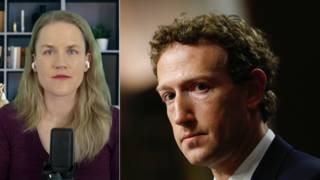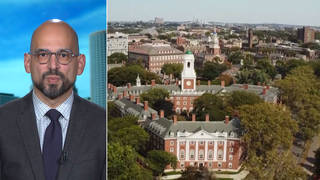
As Russian forces continue to besiege Ukrainian cities, Ukrainian President Volodymyr Zelensky has accused them of reducing the southern city of Mariupol to ashes. All foreign journalists have fled the city as heavy shelling has driven most remaining civilians into hiding in their basements. We speak to Belkis Wille, who just left Ukraine after spending over three weeks documenting the effects of the war and describes “an absolute hellscape” in Mariupol. Disabled people and seniors are often unable to retreat into safe hiding places, says Wille, senior researcher at Human Rights Watch. “The people that we spoke to were the lucky ones. They were the ones with the means and the ability to get out of the city.”
Transcript
AMY GOODMAN: This is Democracy Now!, democracynow.org, The War and Peace Report. I’m Amy Goodman, with Juan González.
Ukrainian President Volodymyr Zelensky has accused Russian forces of reducing the southern city of Mariupol to ashes. Tens of thousands of civilians remain trapped in the strategic port city with little food or water. There are now no foreign journalists in the city to document the destruction.
A team of reporters from the Associated Press recently left Mariupol after spending 20 days in the besieged city. By the end, the reporters said they were being hunted down by Russian forces. AP video journalist Mstyslav Chernov has provided a harrowing account of life under bombardment in Mariupol. I want to read part of his description of what he witnessed. For our television audience, we’ll also show images of Mariupol by Sergii Makarov, the photographer from the area. They were provided to us by Human Rights Watch. These are the words of AP’s Mstyslav Chernov.
He writes, “One bomb at a time, the Russians cut electricity, water, food supplies and finally, crucially, the cell phone, radio and television towers. The few other journalists in the city got out before the last connections were gone and a full blockade settled in. …
“The deaths came fast. On Feb. 27, we watched as a doctor tried to save a little girl hit by shrapnel. She died.
“A second child died, then a third. Ambulances stopped picking up the wounded because people couldn’t call them without a signal, and they couldn’t navigate the bombed-out streets. …
“Shelling hit the hospital and the houses around. It shattered the windows of our van, blew a hole into its side and punctured a tire. Sometimes we would run out to film a burning house and then run back amid the explosions. …
“By this time I had witnessed deaths at the hospital, corpses in the streets, dozens of bodies shoved into a mass grave. I had seen so much death that I was filming almost without taking it in.
“On March 9, twin airstrikes shredded the plastic taped over our van’s windows. I saw the fireball just a heartbeat before pain pierced my inner ear, my skin, my face.
“We watched smoke rise from a maternity hospital. When we arrived, emergency workers were still pulling bloodied pregnant women from the ruins.”
Those are the words of the Associated Press’s Mstyslav Chernov, who spent 20 days in Mariupol documenting the Russian siege.
To talk more about the humanitarian crisis there and across Ukraine, we’re joined by Belkis Wille, senior researcher with the Conflict and Crisis division at Human Rights Watch. She just left Ukraine, where she spent over three weeks. Human Rights Watch has published a new report largely based on her research, titled “Ukraine: Ensure Safe Passage, Aid for Mariupol Civilians: Residents Describe Harsh Conditions During Russian Attack.” She’s joining us now from Zürich, Switzerland.
Belkis, thanks so much for being here. I know you must be dealing with so much trauma now, as you took in the trauma of these testimonies. Describe what you heard from the Mariupol survivors.
BELKIS WILLE: I mean, what I heard was truly, as I think you’ve already depicted well, an absolute hellscape. You know, families were telling me about how they were flushing out the water in their heating systems to try and get access to more water to survive as they spent over two weeks in basements, sheltering from the constant shelling around them, before they were eventually able to get into their own personal vehicles and cars that their friends had and get outside the city. They were also melting snow to get water and going to local streams and rivers. And all of them said that, you know, waiting on these lines, even at local fountains and streams, meant that you were essentially at risk of being shelled. They would go outside of their basements only to cook food on open flame in their yards. And it was in those times when they left their basements that they would see dead bodies strewn outside, dead bodies of people that they knew, families who would say, you know, “We can’t even bury our son, who was killed in an explosion nearby, because the shelling continues and it’s not safe to bury him yet.” The stories were really horrific.
I would say perhaps most difficult stories to hear, though, were from older people and people with disabilities. They, when the electricity was cut, unlike everyone else in the city who went down into these basements to shelter, they couldn’t do that, because no electricity meant they couldn’t take elevators down. And so they sat on their sofas in apartments. You know, I spoke to a man in his eighties. He lived on the sixth floor of his building, sat on his sofa with windows blown out, so no glass between him and these below-freezing temperatures, just watching the shelling and the explosions and the fires from outside his window, hoping that he would survive.
JUAN GONZÁLEZ: And, Belkis Wille, Human Rights Watch has reported the extensive use of cluster munitions by the Russian forces in some places. Could you talk about what you found about that?
BELKIS WILLE: Unfortunately, since this conflict has begun, we have seen multiple instances of Russian forces firing cluster munitions into civilian-populated areas. We saw that in the very early days when the conflict began in Donetsk. We then saw cluster munitions being used on multiple occasions in the city of Kharkiv, the second-biggest city in Ukraine, that has been heavily, heavily damaged in recent attacks. And we’ve even seen cluster munitions used elsewhere in the country. We issued a report on the use on numerous days, in numerous attacks, of cluster munitions in the city of Mykolaiv near Odessa. And in these instances, unfortunately, we have seen civilians injured and killed.
JUAN GONZÁLEZ: And there have been reported instances of violations of attempts at ceasefires in an effort to create humanitarian corridors. What have you found about that? And how have so many people been able to leave despite the lack of an organized form of humanitarian relief through these corridors?
BELKIS WILLE: Officials have tried to negotiate humanitarian corridors, including with the help of independent institutions like the International Committee of the Red Cross, and numerous times have said that these efforts to put in place a short-term ceasefire to allow for a humanitarian corridor to open have failed. The idea is that these corridors would allow for civilians to safely evacuate areas of fighting, but also that urgently needed humanitarian aid could get into areas where there are going to be some civilians that simply can’t flee, some people, as I mentioned, you know, older people, people with disabilities, other people who can’t leave or don’t want to leave the areas that they live in. I would say it’s important to note that, ultimately, the obligation on both sides is to allow civilians to flee safely and for aid to get in, regardless of whether corridors exist or not.
The people of Mariupol waited for days, waiting for news that a corridor would be put in place so that they could evacuate in an organized fashion and evacuate safely. And after days and days and days of waiting, where each of these corridors failed, it was around March 14th that a few people simply decided, “Enough is enough. Either I’m going to die in my basement, or I’m going to die trying to leave the city, and I prefer the latter option.” So they got into their cars, and they just started driving. They knew they were driving into Russian-controlled territory, but eventually were hoping they would make it to the Ukrainian side. One car led to five cars, led to 10 cars. And then, on March 14, as I said, this number grew, and we heard in the news suddenly that 160 cars were trying to make it to the Ukrainian side.
And that’s when my colleague and I actually headed to the area where we knew people would be arriving once they made it back into Ukrainian-controlled territory in the city of Zaporizhzhia. And then we stayed there for two days interviewing some of the thousands of people that then also got into their own vehicles and took the risk of making it out of the city and arriving to safety.
AMY GOODMAN: Belkis, you talk about people getting into their own vehicles. What about people who don’t have them, the most compromised people, the poorest, the disabled, the old?
BELKIS WILLE: Absolutely. That’s the thing that everyone that I interviewed raised with me. They said, you know, “We were sheltering for weeks in a basement with 50 other people, 80 other people. When we heard that cars were trying to get out, we got into our car. Maybe half the people, a quarter of the people who were sheltering with us also had cars and left, but we left behind the others.” And these are people who didn’t have private vehicles, who don’t have the means to leave. And I think the sad reality is that, you know, the people that we spoke to were the lucky ones. They were the ones with the means and the ability to get out of the city. We know from local authorities that they estimate at least 200,000 people are still in the city. And as you say, many of them simply don’t have the means to get out. And that’s why it is so important that humanitarian aid can get into the city, where food stocks are dwindling, where medication is running out, and where so much assistance is urgently needed.
AMY GOODMAN: I wanted to ask you about — more about Kharkiv, the eastern city. These are the voices of volunteers who cleaned debris from residential buildings that have been attacked.
VOLUNTEER 1: [translated] A girl that was walking opposite the medical center was killed. A man wounded with shrapnel in his lungs and another part of his body is laying near entrance five. He was going back home when it happened. He was hit by shrapnel. He was a lieutenant colonel in the reserve. Who else got hit? A grandmother was killed. Her grandson is disabled.
VOLUNTEER 2: [translated] Honestly speaking, I do not see much sense in leaving the city. Joining the Territorial Defense Force? I do not have any military experience, but I can help the city with my labor. Why not?
VOLUNTEER 3: [translated] At the moment, I do not have any work at home. I am 70. I am an engineer with experience. Until yesterday, I had work to do. But when I saw the appeal, I understood this was more urgent, more important, more needed now.
AMY GOODMAN: So, those are the voices of volunteers in Kharkiv. You also have Human Rights Watch documenting Russia’s use of cluster munitions, particularly in another city under siege, in Mykolaiv. If you could talk about these attacks, as well, and what you’ve documented?
BELKIS WILLE: In the city of Kharkiv, we initially were documenting several distinct uses of cluster munitions in the city at a time when many civilians were still there, cluster munitions that did injure and kill civilians. And we more recently have published a much more detailed report that actually looks at 43 individual attacks on civilian property, shops, homes, other common spaces that civilians use, to the point that the city has been so severely damaged. And during the time that these attacks were rocking the city, there wasn’t any safe corridor out. There wasn’t an easy way for civilians to leave. And that’s, unfortunately, why so many were wounded and killed in those attacks.
And then, as you said, the fighting has proceeded on other fronts. The city of Mykolaiv in the last days has been under a heavy shelling and attack. There is a military air base in the city. There is a military factory in the city. But the areas where we’ve seen cluster munitions landing are also in residential neighborhoods. In other parts of the city, we’ve interviewed people who had munitions landing in the middle of their household, that they and their family were still there. And unfortunately, these attacks will continue to wound and kill civilians.
JUAN GONZÁLEZ: I wanted to ask you about the role of countries like Poland in welcoming millions of Ukrainians who are fleeing the war. And they’ve gotten a lot of media attention for that. But at the same time, Poland has continued to close its borders to Syrian, Libyan, Yemenis and people from Africa who are fleeing the devastation in their own countries. For example, on March 2nd, according to press reports, a Polish border guard tweeted, quote, “Last night, 51 foreigners tried to illegally cross into Poland from Belarus. 11 people from Syria, 33 from Iraq, 1 from Burkina Faso and 6 from Congo were arrested.” Now, this is an area, the Belarus border, where foreign journalists are not allowed, while the foreign journalists are allowed to film and report on the refugees being welcomed from Ukraine. What does this say about the nature of, the human rights implications of one group of people being treated one way and another group of people being treated another way?
BELKIS WILLE: I think that’s such an important point to make. I crossed the border out of Ukraine into Poland on Sunday, and I was simply astounded by what I saw. As I crossed the border, I saw dozens of tents from numerous organizations from around the world. As I was getting my bearings straight and figuring out which direction to go in, a man handed me a steaming cup of coffee. Another woman handed me a bowl of soup. Someone was offering me a free SIM card. There were people distributing diapers, baby food, providing free transport to cities in Poland. I mean, this response is incredible.
The welcome that Ukrainians and foreigners in Ukraine who flee from the country are facing is amazing, but at the same time stands in such stark contrast to what we’ve seen at the Polish border, the Polish-Belarus border, only in November, when we saw people being pushed back illegally across the border back into Belarus. We saw people freezing to death in the forest and being beaten by border guards. And as you say, you know, it’s not like volunteer organizations hadn’t wanted to provide assistance at that point to people stuck on the border, but they weren’t allowed to. So I think it is disturbing to see this difference. And all I can hope is that now that we’ve seen what a welcoming response can look like and should look like, that that is extended to all refugees and asylum seekers that are fleeing war.
AMY GOODMAN: In fact, didn’t you go into Ukraine to investigate what was happening to African students, for example, who were trying to flee Ukraine?
BELKIS WILLE: In the first days of the war, in particular, we had a country — Ukraine is a country that has many, many tens of thousands of foreign students that study there, students from India, Nigeria, China, Morocco, all over the world. And when the conflict started, you saw many people trying to get on trains and buses to get to the border, the border with Poland and other borders. And priority was being given to Ukrainian women and Ukrainian children. And those spaces on buses and on trains were actually being prevented for boarding for many foreign students. I interviewed many students who eventually made it to the western city of Lviv — Indian students, Moroccan students, Algerian students — and they described to me how they were pushed off of buses. They were pushed off of trains. They were prevented from boarding because, you know, local authorities were telling them, “Priority is given to Ukrainian women and children, not to you.”
AMY GOODMAN: Belkis Wille, we want to thank you for being with us, senior researcher with the Conflict and Crisis division at Human Rights Watch, just left Ukraine, where she spent over three weeks documenting the effects of the war across the country. Human Rights Watch has published a new report largely based on her research, and we will link to it at democracynow.org.
Coming up, we’ll speak with a pacifist in Kyiv. Stay with us.













Media Options